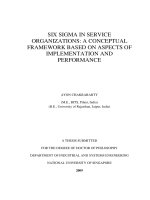BASIC SIX SIGMA APPLICATIONS COURSE
Bạn đang xem bản rút gọn của tài liệu. Xem và tải ngay bản đầy đủ của tài liệu tại đây (8.58 MB, 299 trang )
INTRODUCTION TO SIX
SIGMA APPLICATIONS
What is Six Sigma?
A Philosophy
Customer Critical To Quality (CTQ) Criteria
Breakthrough Improvements
Fact-driven, Measurement-based, Statistically Analyzed
Prioritization
Controlling the Input & Process Variations Yields a Predictable
Product
A Quality Level
6s = 3.4 Defects per Million Opportunities
A Structured Problem-Solving Approach
Phased Project:
Measure, Analyze, Improve, Control
A Program
Dedicated, Trained BlackBelts
Prioritized Projects
Teams - Process Participants & Owners
POSITIONING SIX SIGMA
THE FRUIT OF SIX SIGMA
Sweet Fruit
Design for Manufacturability
Process Entitlement
Bulk of Fruit
Process Characterization
and Optimization
Low Hanging Fruit
Seven Basic Tools
Ground Fruit
Logic and Intuition
UNLOCKING THE HIDDEN FACTORY
VALUE
STREAM TO
THE
CUSTOMER
PROCESSES WHICH
PROVIDE PRODUCT VALUE
IN THE CUSTOMER’S EYES
•FEATURES OR
CHARACTERISTICS THE
CUSTOMER WOULD PAY
FOR….
WASTE DUE TO
INCAPABLE
PROCESSES
WASTE SCATTERED THROUGHOUT
THE VALUE STREAM
•
•
•
•
•
•
EXCESS INVENTORY
REWORK
WAIT TIME
EXCESS HANDLING
EXCESS TRAVEL DISTANCES
TEST AND INSPECTION
Waste is a significant cost driver and has a major
impact on the bottom line...
Common Six Sigma Project Areas
Manufacturing Defect Reduction
Cycle Time Reduction
Cost Reduction
Inventory Reduction
Product Development and Introduction
Labor Reduction
Increased Utilization of Resources
Product Sales Improvement
Capacity Improvements
Delivery Improvements
The Focus of Six Sigma…..
All critical characteristics (Y)
are driven by factors (x) which
are “upstream” from the
results….
Y = f(x)
Attempting to manage results
(Y) only causes increased
costs due to rework, test and
inspection…
Understanding and controlling
the causative factors (x) is the
real key to high quality at low
cost...
SIX SIGMA COMPARISON
Traditional
Six Sigma
Focus on Prevention
Focus on Firefighting
Low cost/high throughput
High cost/low throughput
Poka Yoke Control Strategies
Reliance on Test and Inspection
Stable/Predictable Processes
Processes based on Random Probability
Proactive
Reactive
Low Failure Rates
High Failure Rates
Focus on Long Term
Focus on Short Term
Efficient
Wasteful
Manage by Metrics and Analysis
Manage by “Seat of the pants”
“SIX SIGMA TAKES US FROM FIXING PRODUCTS SO THEY ARE EXCELLENT,
TO FIXING PROCESSES SO THEY PRODUCE EXCELLENT PRODUCTS”
Dr. George Sarney, President, Siebe Control Systems
IMPROVEMENT ROADMAP
Objective
Phase 1:
Measurement
Characterization
Phase 2:
Analysis
Breakthrough
Strategy
Phase 3:
Improvement
Optimization
Phase 4:
Control
•Define the problem and
verify the primary and
secondary measurement
systems.
•Identify the few factors
which are directly
influencing the problem.
•Determine values for the
few contributing factors
which resolve the
problem.
•Determine long term
control measures which
will ensure that the
contributing factors
remain controlled.
Measurements are critical...
•If we can’t accurately measure
something, we really don’t know much
about it.
•If we don’t know much about it, we
can’t control it.
•If we can’t control it, we are at the
mercy of chance.
WHY STATISTICS?
THE ROLE OF STATISTICS IN SIX SIGMA..
WE DON’T KNOW WHAT WE DON’T KNOW
LSL
T
USL
IF WE DON’T HAVE DATA, WE DON’T KNOW
IF WE DON’T KNOW, WE CAN NOT ACT
IF WE CAN NOT ACT, THE RISK IS HIGH
IF WE DO KNOW AND ACT, THE RISK IS MANAGED
IF WE DO KNOW AND DO NOT ACT, WE DESERVE THE LOSS.
DR. Mikel J. Harry
TO GET DATA WE MUST MEASURE
DATA MUST BE CONVERTED TO INFORMATION
INFORMATION IS DERIVED FROM DATA THROUGH
STATISTICS
WHY STATISTICS?
THE ROLE OF STATISTICS IN SIX SIGMA..
Ignorance is not bliss, it is the food of failure
and the breeding ground for loss.
DR. Mikel J. Harry
LSL
T
USL
Years ago a statistician might have claimed that
statistics dealt with the processing of data….
Today’s statistician will be more likely to say that
statistics is concerned with decision making in the
face of uncertainty.
Bartlett
WHAT DOES IT MEAN?
Sales Receipts
On Time Delivery
Process Capacity
Order Fulfillment Time
Reduction of Waste
Product Development Time
Process Yields
Scrap Reduction
Inventory Reduction
Floor Space Utilization
Random Chance or Certainty….
Which would you choose….?
The Focus of Six Sigma…..
All critical characteristics (Y)
are driven by factors (x) which
are “downstream” from the
results….
Y = f(x)
Attempting to manage results
(Y) only causes increased
costs due to rework, test and
inspection…
Understanding and controlling
the causative factors (x) is the
real key to high quality at low
cost...
INTRODUCTION TO
PROBABILITY
DISTRIBUTIONS
Why do we Care?
An understanding of
Probability Distributions is
necessary to:
•Understand the concept and
use of statistical tools.
•Understand the significance of
random variation in everyday
measures.
•Understand the impact of
significance on the successful
resolution of a project.
IMPROVEMENT ROADMAP
Uses of Probability Distributions
Project Uses
Phase 1:
Measurement
•Establish baseline data
characteristics.
Characterization
Phase 2:
Analysis
Breakthrough
Strategy
Phase 3:
Improvement
Optimization
Phase 4:
Control
•Identify and isolate
sources of variation.
•Demonstrate before and
after results are not
random chance.
•Use the concept of shift &
drift to establish project
expectations.
KEYS TO SUCCESS
Focus on understanding the concepts
Visualize the concept
Don’t get lost in the math….
Measurements are critical...
•If we can’t accurately measure
something, we really don’t know much
about it.
•If we don’t know much about it, we
can’t control it.
•If we can’t control it, we are at the
mercy of chance.
Types of Measures
Measures where the metric is composed of a
classification in one of two (or more) categories is
called Attribute data. This data is usually presented
as a “count” or “percent”.
Good/Bad
Yes/No
Hit/Miss etc.
Measures where the metric consists of a number
which indicates a precise value is called Variable
data.
Time
Miles/Hr
COIN TOSS EXAMPLE
Take a coin from your pocket and toss it 200 times.
Keep track of the number of times the coin falls as
“heads”.
When complete, the instructor will ask you for your
“head” count.
COIN TOSS EXAMPLE
Results from 10,000 people doing a coin toss 200 times.
Count Frequency
Results from 10,000 people doing a coin toss 200 times.
Cumulative Count
600
Frequency
500
400
Cumulative Frequency
300
200
100
5000
0
0
80
90
100
110
120
130
"Head Count"
Cumulative count is simply the total frequency
count accumulated as you move from left to
right until we account for the total population of
10,000 people.
Since we know how many people were in this
population (ie 10,000), we can divide each of the
cumulative counts by 10,000 to give us a curve
with the cumulative percent of population.
70
80
90
100
110
120
130
Results from 10,000 people doing a coin toss 200 times.
Cumulative Percent
100
Cumulative Percent
70
Cumulative Percent
C umulative Frequency
10000
50
0
70
80
90
100
110
"Head Count"
120
130
COIN TOSS PROBABILITY EXAMPLE
Results from 10,000 people doing a coin toss 200 times
Cumulative Percent
This means that we can now
predict the change that
certain values can occur
based on these percentages.
Cumulative Percent
100
50
Note here that 50% of the
values are less than our
expected value of 100.
0
70
80
90
100
110
120
130
This means that in a future
experiment set up the same
way, we would expect 50%
of the values to be less than
100.
COIN TOSS EXAMPLE
Results from 10,000 people doing a coin toss 200 times.
Count Frequency
We can now equate a probability to the
occurrence of specific values or groups of
values.
600
Frequency
500
400
300
200
100
0
70
80
90
100
110
120
130
"Head Count"
Results from 10,000 people doing a coin toss 200 times.
Cumulative Percent
Cumulative Percent
100
50
0
70
80
90
100
110
"Head Count"
120
130
For example, we can see that the
occurrence of a “Head count” of less than
74 or greater than 124 out of 200 tosses
is so rare that a single occurrence was
not registered out of 10,000 tries.
On the other hand, we can see that the
chance of getting a count near (or at) 100
is much higher. With the data that we
now have, we can actually predict each of
these values.
COIN TOSS PROBABILITY DISTRIBUTION
PROCESS CENTERED
ON EXPECTED VALUE
% of population = probability of occurrence
600
SIGMA (s ) IS A MEASURE
OF “SCATTER” FROM THE
EXPECTED VALUE THAT
CAN BE USED TO
CALCULATE A PROBABILITY
OF OCCURRENCE
500
Frequency
If we know where
we are in the
population we can
equate that to a
probability value.
This is the purpose
of the sigma value
(normal data).
400
300
200
s
100
0
70
NUMBER OF HEADS
SIGMA VALUE (Z)
CUM % OF POPULATION
80
90
100
110
120
130
58
65
72
79
86
93
100
107
114
121
128
135
142
-6
-5
-4
-3
-2
-1
0
1
2
3
4
5
6
.003
.135
2.275
15.87
50.0
84.1
97.7
99.86
99.997
WHAT DOES IT MEAN?
Common Occurrence
Rare Event
What are the chances that this
“just happened” If they are small,
chances are that an external
influence is at work that can be
used to our benefit….









